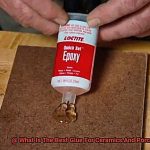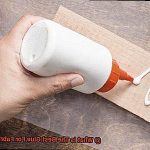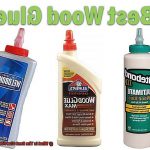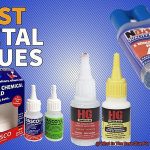Metal to metal bonding can be a tricky business. You don’t want to end up with a weak bond that will fail at the slightest pressure, do you? That’s where epoxy comes in – it’s one of the most reliable adhesives for metal to metal bonding. But, with so many options on the market, how do you know which one to choose?
Don’t worry, we’ve got your back. In this blog post, we’ll take you on a journey through the world of epoxy adhesives and show you some of the best ones for your metal bonding needs.
First things first – why is it important to choose the right epoxy adhesive for your metal bonding project? Well, using the wrong adhesive could lead to disastrous results – think broken parts and wasted resources. We’ll guide you through the key features to look for in a quality metal to metal epoxy, such as strength, durability, and ease of use.
Now let’s get down to business. There are different varieties of epoxy adhesives available – two-part, one-part, and structural epoxies. Each has its pros and cons depending on your specific needs. We’ll give you real-world examples of when each type would be most appropriate so that you can make an informed decision.
By the time you’re done reading this article, you’ll have a better understanding of what makes an excellent epoxy adhesive for metal to metal bonding. Whether you’re a professional mechanic or just need to fix something around the house, rest assured that you’re choosing the right adhesive for the job.
Types of Epoxy for Metal-to-Metal Bonding
Contents
- 1 Types of Epoxy for Metal-to-Metal Bonding
- 2 Factors to Consider When Choosing an Epoxy for Metal-to-Metal Bonding
- 3 Shear Strength: The Most Important Factor in Metal-to-Metal Bonding
- 4 Curing Time: How Long Does Epoxy Take to Reach Full Strength?
- 5 Environmental Factors: Choosing an Epoxy for Specific Conditions
- 6 Different Types of Epoxies Suitable for Metal-to-Metal Bonding
- 7 Advantages and Disadvantages of Using Epoxy for Metal-to-Metal Bonding
- 8 Tips on Applying and Curing Epoxies for Maximum Strength
- 9 Conclusion
Epoxy is a popular adhesive for metal-to-metal bonding due to its strength, durability, and resistance to chemicals and moisture. However, not all epoxies are created equal when it comes to metal bonding. Here are five sub-sections explaining the different types of epoxy available for metal-to-metal bonding and their specific properties.
Two-Part Epoxy
This type of epoxy is one of the most commonly used for metal-to-metal bonding. It consists of two components – a resin and a hardener – that must be mixed together before use. Two-part epoxy forms a strong bond and can be used on various metals, including aluminum, steel, and copper.
Structural Epoxy
If you need a high-strength bond, structural epoxy is the way to go. It’s often used in industrial applications and can withstand harsh environments. Structural epoxy is also resistant to chemicals and temperature changes, making it ideal for demanding applications.
Flexible Epoxy
For bonding metals with different coefficients of thermal expansion, such as aluminum and steel, a flexible epoxy is recommended. This type of epoxy can absorb stress caused by temperature changes and prevent the bond from cracking or weakening over time.
Fast-Curing Epoxy
When time is critical, fast-curing epoxy is an excellent choice. As the name suggests, this type of epoxy cures quickly and does not require extensive preparation before bonding.
Specialty Epoxies
Different types of specialty epoxies are available for specific applications. Conductive epoxies are ideal for bonding metals that require electrical conductivity, such as copper or aluminum. Heat-resistant epoxies are suitable for metals that will be subjected to high temperatures, such as in aerospace or automotive industries.
It’s crucial to consider factors such as the type of metals being bonded and the application environment when choosing an epoxy for metal-to-metal bonding. By selecting the right type of epoxy, you can ensure a strong and long-lasting bond between two metal surfaces. Additionally, epoxy adhesives come in different forms, such as paste, liquid, or film.
Factors to Consider When Choosing an Epoxy for Metal-to-Metal Bonding
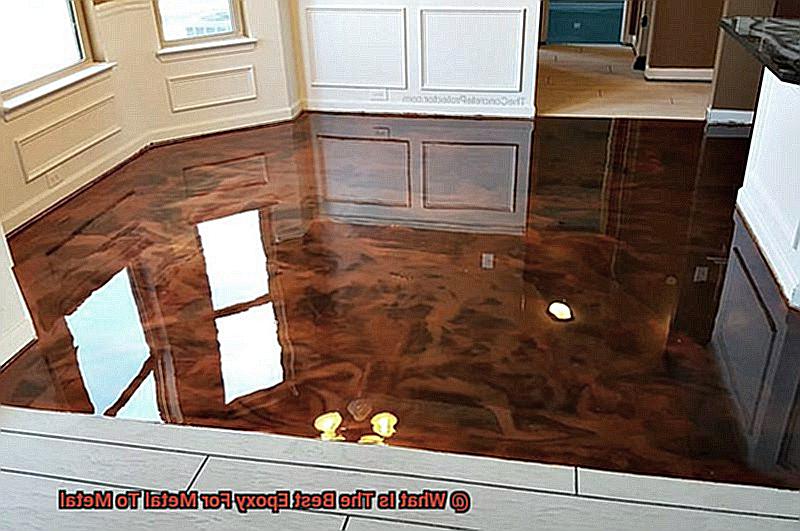
When it comes to bonding metal to metal, choosing the right epoxy is critical for a strong and durable bond. As an expert in this field, I can tell you that there are several factors to consider when selecting an epoxy. Here are some of the key factors that you should keep in mind:
Firstly, the type of metal being bonded plays a crucial role in determining the best epoxy. Each metal has its unique properties, and some metals, such as aluminum or stainless steel, may require a specialized epoxy to ensure a strong bond.
Secondly, proper surface preparation is essential for a successful bond. The metal surfaces should be clean, dry, and free of any contaminants like oil or grease. Roughening the surface with sandpaper or a wire brush can also improve adhesion.
Thirdly, consider the strength requirements of the bond when selecting an epoxy. The strength of the bond can vary depending on the specific epoxy used. Therefore, it’s important to choose one that meets your necessary strength requirements.
Fourthly, temperature and environmental conditions can affect epoxy bonds. For instance, humidity and exposure to UV light can weaken the bond over time. Therefore, it’s crucial to choose an epoxy that can withstand your intended environmental conditions.
Finally, cure time is another significant factor to consider for maximum strength. This refers to the amount of time it takes for the epoxy to fully harden. Cure time can vary depending on the specific epoxy used and can range from a few hours to several days.
To summarize, here’s what you need to consider when choosing an epoxy for metal-to-metal bonding:
- Type of metal
- Surface preparation
- Strength requirements
- Temperature and environmental conditions
- Cure time
Shear Strength: The Most Important Factor in Metal-to-Metal Bonding
When it comes to metal-to-metal bonding, there’s one factor that reigns supreme: shear strength. It’s the critical measurement of a material’s ability to resist sliding or tearing forces that act in opposite directions parallel to the surface. In other words, it’s the measure of how well two metal surfaces can stick together and withstand pulling forces.
If you want a strong and lasting bond between two metals, you need an epoxy with high shear strength values. The right epoxy will be able to withstand the stresses and strains that the bond will be subjected to during its lifetime. But achieving high shear strength requires careful consideration of several factors.
Firstly, proper surface preparation is key. The surface of both metals being bonded must be free of contaminants or oxidation, and roughened or etched to provide a better mechanical grip for the epoxy. This ensures maximum adhesion between the two surfaces and helps to prevent any potential weaknesses in the bond.
Secondly, selecting the right type of epoxy is crucial. Two-part epoxies are generally recommended for metal-to-metal bonding because they offer high strength and good adhesion. They also cure in a reasonable amount of time, allowing for efficient production times.
But why is shear strength so important? Well, when two metal surfaces are bonded together, they’re likely to experience significant stress and strain during their lifetime. Whether it’s due to environmental factors or mechanical wear and tear, the bond needs to be strong enough to withstand these forces without breaking or failing.
In summary, if you’re looking for a strong and durable bond between two metal surfaces, don’t underestimate the importance of shear strength. Proper surface preparation and selecting the right type of epoxy can help achieve those values and ensure your bond can withstand whatever forces come its way.
Curing Time: How Long Does Epoxy Take to Reach Full Strength?
Look no further than curing time – a crucial factor in the process of achieving maximum strength for your bond.
Curing time is defined as the time it takes for the epoxy to harden completely and attain its full strength. However, this time can vary depending on several factors such as temperature, humidity, and the type of epoxy used.
Let’s break down how each of these factors can impact curing time:
- Temperature: The higher the temperature, the quicker the curing process. Conversely, a colder environment means a slower hardening process. It’s essential to choose an epoxy that aligns with your project’s environment conditions.
- Humidity: High humidity can extend curing time by preventing moisture from evaporating from the surface of the epoxy. If you’re working in a humid environment, an epoxy with a longer curing time may be necessary.
- Type of Epoxy: Different epoxies have varying curing times. Some fast-curing epoxies can harden within an hour or two, while others may require up to a week or more to reach their maximum strength. Be sure to consider your project timeline when selecting an epoxy.
It’s important to note that curing time is not equivalent to drying time. Epoxy may appear dry after a few hours, but it may not have reached its full strength until after several days.
When selecting an epoxy for metal to metal bonding, consider curing time carefully. A longer curing time may be advisable in colder temperatures or high humidity environments, while a faster curing time may be advantageous for projects that require quick turnaround times.
Environmental Factors: Choosing an Epoxy for Specific Conditions
The key to a successful bonding process lies in understanding the environmental factors that can impact your bond strength. As an expert in all things epoxy, let me guide you through the three main factors that can make or break your bonding process: temperature, humidity, and chemical exposure.
Temperature plays a crucial role in the bonding process. Not all epoxies can handle high temperatures, so it’s important to choose one that can withstand the specific temperature conditions your metal parts will be exposed to. Otherwise, your bond may lose its strength or become brittle over time.
Humidity is another critical factor to consider. High humidity levels can affect the curing time of some epoxies, while others may not cure properly at all. Exposure to liquids like water can also weaken the bond if the epoxy is not waterproof. It’s therefore essential to choose an epoxy that’s resistant to moisture and liquids if your metal parts will be exposed to them.
Chemical exposure is yet another crucial factor that cannot be overlooked. Exposure to chemicals like acids, solvents, or oils can break down the bond over time and compromise the structural integrity of the joint. Choosing an epoxy that’s resistant to these substances is vital for long-lasting bonding.
In summary, when choosing an epoxy for metal to metal bonding, it’s important to consider the environmental factors that will affect bond strength. Here’s a quick checklist of things you should consider:
- Temperature: Choose an epoxy that can withstand the specific temperature conditions your metal parts will be exposed to.
- Humidity: Select an epoxy that’s resistant to moisture and liquids if your metal parts will be exposed to them.
- Chemical exposure: Choose an epoxy that’s resistant to chemicals like acids, solvents, or oils if your metal parts will be exposed to them.
Different Types of Epoxies Suitable for Metal-to-Metal Bonding
When it comes to bonding metal to metal, epoxy is the adhesive of choice because it creates a strong and durable bond. However, not all epoxies are created equal, and some are better suited for metal-to-metal bonding than others. Here are five different types of epoxies that are commonly used for this purpose:
Two-part epoxy is the most popular type of epoxy used for metal-to-metal bonding. It consists of two components, a resin and a hardener, which must be mixed together before use. Once mixed, two-part epoxies create a strong and durable bond that can withstand significant stress and strain. This type of epoxy is ideal for applications that require a high-strength bond, such as in construction or automotive industries.
One-part epoxy is pre-mixed and ready to use right out of the package. They are ideal for applications where a quick and easy solution is needed. However, one-part epoxies may not be as strong as two-part epoxies and may not hold up as well under heavy loads or extreme temperatures. One-part epoxies are suitable for lighter-duty applications that do not require the same level of strength as two-part epoxy.
Structural epoxy is designed specifically for high-stress applications where maximum strength is required. They are ideal for bonding metals that will be subjected to heavy loads or constant vibration. Structural epoxies provide excellent resistance to impact, fatigue, and chemical exposure. This type of epoxy is commonly used in the aerospace industry to bond aircraft components.
Conductive epoxy is designed for use in electrical applications where a conductive bond is required. They are commonly used in the electronics industry for bonding components to circuit boards. Conductive epoxies can also be used to create electromagnetic interference (EMI) shielding.
Heat-resistant epoxy is formulated to withstand high temperatures without breaking down or losing its bonding strength. They are ideal for bonding metals that will be subjected to extreme heat, such as engine parts or exhaust systems. Heat-resistant epoxies are commonly used in the automotive industry to bond exhaust systems and engine components.
Advantages and Disadvantages of Using Epoxy for Metal-to-Metal Bonding
Epoxy is a popular choice for bonding metal to metal due to its exceptional strength, durability, and versatility. Still, it’s essential to consider a few factors before selecting this adhesive.
Firstly, let’s explore the advantages of using epoxy for metal-to-metal bonding. Epoxy is one of the strongest adhesives available for this purpose. It creates an exceptionally robust bond that resists heat, chemicals, and water. This quality makes it ideal for a wide range of applications. Furthermore, epoxy is easy to use and apply. Its two-part system is mixed before application and then directly applied to the metal surfaces that need bonding. This feature makes it an attractive option for professionals and DIY enthusiasts alike.
Epoxy can also be used on various metals like steel, aluminum, and copper, as well as on surfaces like wood, plastic, and glass. Its versatility makes it an adhesive of choice for many different industries. Additionally, epoxy has an extended working time before setting completely, allowing for adjustments to be made before the adhesive cures. This characteristic is particularly helpful when bonding larger parts or pieces that require precise placement.
Let’s now consider the disadvantages of using epoxy for metal-to-metal bonding. One significant drawback is its cost compared to other adhesives. Epoxy can be expensive, making it less feasible for some projects. Additionally, it can take a long time to cure fully – sometimes up to 24 hours or more – which may not be ideal for applications with tight deadlines.
Another disadvantage is that epoxy may not work well on surfaces that are oily or greasy. Thus care must be taken to ensure that the surfaces are thoroughly cleaned and prepped before application. Lastly, epoxy can be challenging to remove once cured completely; thus, making repairs or adjustments to the bonded surfaces can be difficult.
Tips on Applying and Curing Epoxies for Maximum Strength
When bonding metal to metal, epoxy is a reliable adhesive that can provide a strong and durable bond. However, to achieve maximum strength, it’s essential to apply and cure the epoxy correctly. Here are some tips to help you get the most out of your epoxy bonding experience:
Prepare the surface
Before applying epoxy, ensure that the surfaces you intend to bond are clean and dry. Any oil, grease, or rust can affect the bonding process negatively. Use sandpaper or a degreaser to remove any debris and ensure optimal bonding.
Mix accurately
The ratio of resin and hardener is crucial in achieving maximum strength when using epoxy. Follow the manufacturer’s instructions carefully when mixing these two components. Ensure that you have measured precisely for optimal results.
Apply evenly
Using a brush or spatula, apply the epoxy evenly to one surface. Avoid applying too much epoxy, which can lead to weak bonding. Apply the adhesive in thin layers, allowing each layer to dry before applying the next.
Join surfaces
Once you have applied the epoxy, align and join both surfaces together while applying pressure. Use clamps or weights to hold them together while the epoxy cures for optimal bonding.
Curing time
The curing time for epoxies varies depending on the type of adhesive used and environmental conditions such as temperature and humidity. Always follow the manufacturer’s instructions carefully for optimal curing time.
Post-curing
After the initial curing time, it’s recommended to post-cure the bonded surfaces by subjecting them to higher temperatures for a few hours. This process helps increase bond strength significantly, ensuring optimal results.
sMrY7_V0I5A” >
Conclusion
To sum up, epoxy is the go-to adhesive for metal-to-metal bonding. However, not all epoxies are created equal, and selecting the right one for your specific needs is crucial. There are various types of epoxies available, including two-part, one-part, and structural epoxies, each with its unique advantages and disadvantages. When making a decision, consider factors such as strength, durability, ease of use, temperature resistance, and curing time.
When it comes to metal-to-metal bonding, shear strength is the most critical factor since it measures a material’s ability to resist sliding or tearing forces that act parallel to the surface. Achieving high shear strength values requires proper surface preparation and selecting the right type of epoxy.
To achieve maximum bond strength when applying and curing epoxies, follow these essential steps: prepare surfaces properly; mix accurately; apply evenly; join surfaces while applying pressure; and follow recommended curing times. Post-curing can also significantly increase bond strength.
While there are some drawbacks associated with using epoxy for metal-to-metal bonding such as cost and difficulty in removing once cured completely; its advantages such as exceptional strength and versatility make it an adhesive of choice for many different industries.



